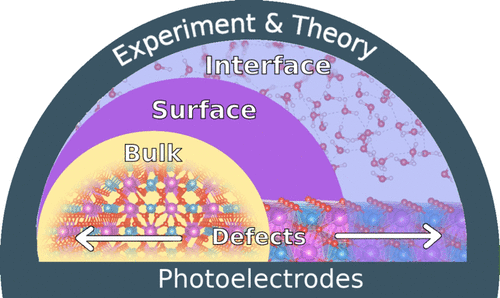当前位置:
X-MOL 学术
›
Acc. Chem. Res.
›
论文详情
Our official English website, www.x-mol.net, welcomes your feedback! (Note: you will need to create a separate account there.)
Integrating Computation and Experiment to Investigate Photoelectrodes for Solar Water Splitting at the Microscopic Scale
Accounts of Chemical Research ( IF 18.3 ) Pub Date : 2021-10-07 , DOI: 10.1021/acs.accounts.1c00418 Wennie Wang 1 , Andjela Radmilovic 2 , Kyoung-Shin Choi 2 , Giulia Galli 1, 3, 4
Accounts of Chemical Research ( IF 18.3 ) Pub Date : 2021-10-07 , DOI: 10.1021/acs.accounts.1c00418 Wennie Wang 1 , Andjela Radmilovic 2 , Kyoung-Shin Choi 2 , Giulia Galli 1, 3, 4
Affiliation

|
Photoelectrochemical water-splitting is a promising and sustainable way to store the energy of the sun in chemical bonds and use it to produce hydrogen gas, a clean fuel. The key components in photoelectrochemical cells (PECs) are photoelectrodes, including a photocathode that reduces water to hydrogen gas and a photoanode that oxidizes water to oxygen gas. Materials used in photoelectrodes for PECs must effectively absorb sunlight, yield photogenerated carriers, and exhibit electronic properties that enable the efficient shuttling of carriers to the surface to participate in relevant water-splitting reactions. Discovering and understanding the key characteristics of optimal photoelectrode materials is paramount to the realization of PEC technologies.
中文翻译:

结合计算和实验在微观尺度上研究用于太阳能水分解的光电极
光电化学水分解是一种有前景且可持续的方法,可以将太阳能以化学键的形式储存起来,并用它来生产氢气,一种清洁燃料。光电化学电池 (PEC) 的关键部件是光电极,包括将水还原为氢气的光阴极和将水氧化为氧气的光阳极。用于 PEC 光电极的材料必须有效吸收阳光,产生光生载流子,并表现出能够使载流子有效穿梭到表面以参与相关水分解反应的电子特性。发现和理解最佳光电极材料的关键特性对于实现 PEC 技术至关重要。
更新日期:2021-10-19
中文翻译:

结合计算和实验在微观尺度上研究用于太阳能水分解的光电极
光电化学水分解是一种有前景且可持续的方法,可以将太阳能以化学键的形式储存起来,并用它来生产氢气,一种清洁燃料。光电化学电池 (PEC) 的关键部件是光电极,包括将水还原为氢气的光阴极和将水氧化为氧气的光阳极。用于 PEC 光电极的材料必须有效吸收阳光,产生光生载流子,并表现出能够使载流子有效穿梭到表面以参与相关水分解反应的电子特性。发现和理解最佳光电极材料的关键特性对于实现 PEC 技术至关重要。


























 京公网安备 11010802027423号
京公网安备 11010802027423号